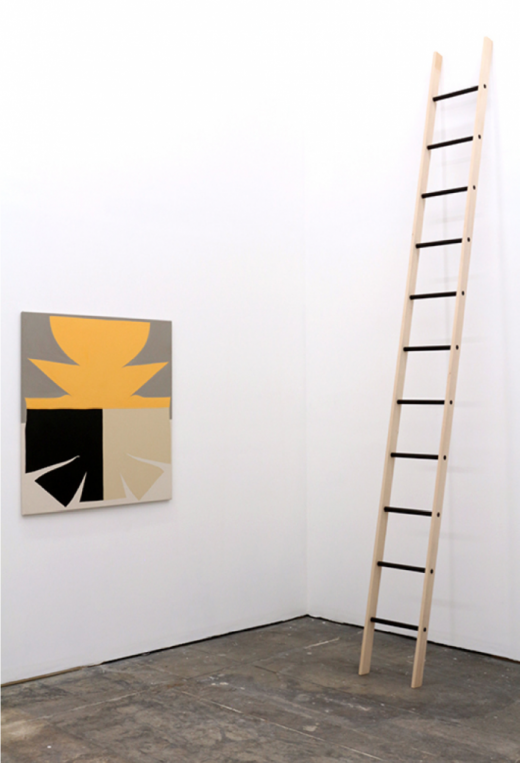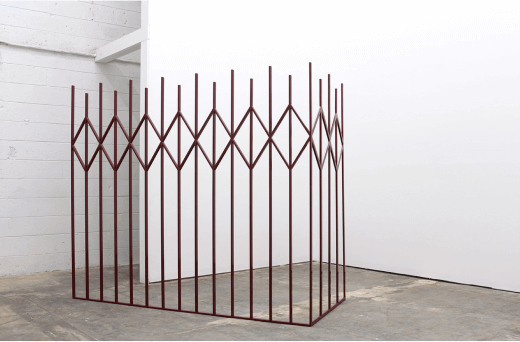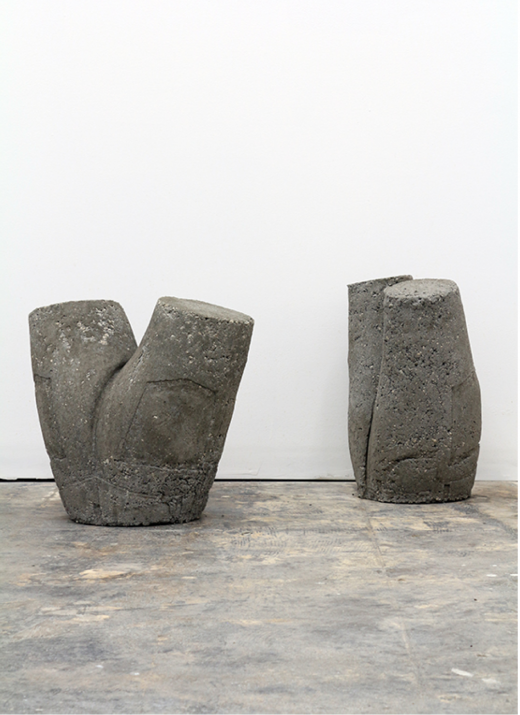- Gold and Ice Cream: Two Paths for Colombian Contemporary Art

- Betty Woodman—CONTRO VERSIES CONTRO VERSIA: An inaccurate history of painting and ceramics
Newz!: Math Bass
Martha Raoli

Math Bass, Pattern Symbol and Eleven Rung Rise, both 2013.
November 13th, 2013 – January 10, 2014
Math Bass’s work mostly occurs as one-night-only theatrical performances populated by elements like dogs, fog, cement pants, ladders, blankets, and plants. Long after the actors have exited the stage, latent sculptural objects lie about in repose, still charged with the energy of performance. Michael Jon Gallery offers us a lean and quiet grouping of Bass’s sculptural idioms: a powder-coated fence and a ladder, concrete legs cast in now-absent denim, and an abstract painting. If you know of her performative practice, it’s hard not to consider these pieces as stage props, but they still beg to be considered on their own terms. They are, like Bass performances, unresponsive to linear narrative, or to hyperbole. Favoring a natural choreography, Bass directs her troupe of untrained volunteer friends and acquaintances to refrain from overly theatrical gestures. “I tell my actors they don’t have to be dramatic. What they’re doing is dramatic,” she told me at my studio. Lying and hanging with tacit deshabille, these sculptures have been coaxed into a state of relaxed beingness. In NEWZ!, you walk onto a sparse set that feels potent with performative possibility. These decidedly serene sculptures are theatricalized by their placement in the gallery. They ooze dramatic mojo.

Math Bass, Rose Gate (2013), Powder-coated Steel.
Nominally, “Rose Gate” is all formal gardens and tender countryside blooms, but truth is, this gate refers to a pervasive architectural detail shielding houses from the streets of L.A. Steel pickets powder-coated a high-gloss shade of burgundy—not too rosy. The contrast between language and artifact here displaces actuality with dreamy romanticism. I think of that prickly fence Louise Bourgeois painted cheery pink but named cheekily, “The Blind Leading the Blind” (1947-1949). Bass’s gate belongs to a tradition of archi-sculpture that applies sardonic whimsy to classical structures.

Math Bass, Where Two Becomes One (2013), Concrete.
Stumpy and truncated, these sculptures are lopped off Hellenistic amputee sculptures or short summer jeans. Like fossils of bygone fashion, imprinted with detail of grommet, pocket and seam, they describe popular fashion in vaguely archeological terms. These pieces are not representations of jeans, but of the space the body occupied within the pants’ well-worn contours; the jeans are outlines, filled in with cement. They are absence, quantified empirically: a likeness of a body, told in fragment. Ancient bust. Crotch Shots. Bottoms up.
Bass also made long-legged jean sculptures, one of which you may have seen at Michael Jon Gallery’s booth at UNTITLED. this December. Ankles pointing up towards the tented ceiling, hips eclipsed by the ground’s horizon, as if the torso were buried under the beachfront sand, sinking, suggested a polar tension between being pulled down and being pulled upright, an action not unlike removing a too tight pair of jeans.
In her practice, Bass often tents chairs, or her own body, in soft sculpture. One of these soft sculptures has been cut open, flattened like a dressmakers’ pattern or animal hide, and traced onto a stretched canvas called “Symbol Object” (2013). The splayed-out form is then rendered in pigment. It is a drawing of a deflated object, a kind of shadow. Straight from the can—grey, yellow ochre, black and sand—housepaint color-blocks the raw canvas in asymmetric heraldic shapes. Sharp points give way to swerving painterly flourishes: the wispy tails of a silken coat of arms resting loosely over the taut canvas. Naked moments of exposed raw canvas formalize the impression that there is a flap of fabric lying over the background. As such, a third dimension opens in an otherwise super-flat painting, one now vibrating between these two states—flatness and depth, representation and abstraction.
With the vulnerability of an architectural maquette, an elegant ladder called “Eleven Rung Rise” (2013) leans against the gallery wall. Its simplicity is its camouflage. The legs are velvety planks of what looks like soft balsa but is actually the coincidentally named basswood. Thanks to the matte semi-opaque black stain—made exclusively for Rick Owens—the cylindrical rungs emit the fragility of charcoal drawing sticks. In a mortise and tenon joint, these horizontal dowels fit into holes along the legs of the ladder to the effect of cute black circles that run up like buttons so neat and tight they appear to be one flush surface. No glue, just physics. This is impeccable craftsmanship, with the genetic underpinnings of punk rock subversive fashion and the ethereal nudity of popsicle sticks.
Yet for all its allusions and dramatic potential, the work in NEWZ! is bare bones, made with a blue-collar production ethos. Structural building strategies of cement pouring, steelwork, house painting and carpentry are deployed, necessarily. Material is reflexive to form. Artmaking is neither fancified nor hidden, and this transparency of craftsmanship in these highly articulated sculptures mystifies them.









